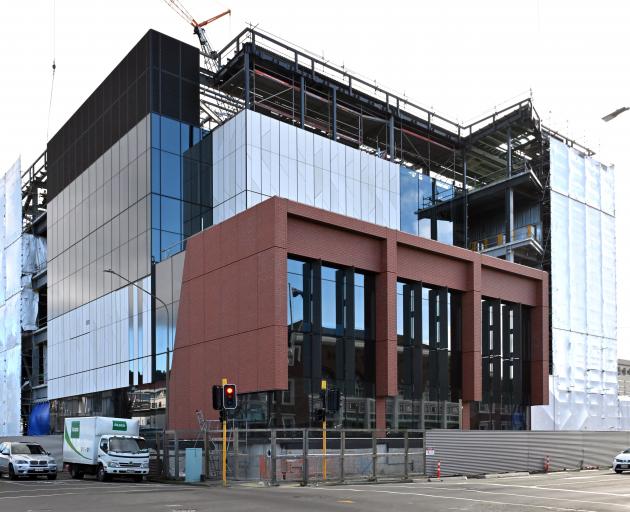
The cost of building new hospitals and patching up old ones is expected to escalate to nearly $47 billion over the next decade, according to a Health New Zealand report.
That is the equivalent of two or three new Dunedin Hospitals every year for the next 10 years.
The briefing to Health Minister Shane Reti - obtained by RNZ under the Official Information Act - also shows the bill to fix failing pipes, ancient wiring and other problems at ageing public hospitals is likely to be hundreds of millions of dollars, with 82 "very high priority risks" identified.
The Nation-wide Service and Campus Planning report, which was signed off by Te Whatu Ora's board in December and went to the Minister in April, shows:
- Existing plans for 300 infrastructure projects on track to cost $46.9b over the next decade
- The cash injection requested by hospitals ahead of each Budget for new builds and redevelopments has mushroomed from $15b in 2020, to $24b in 2022, to $34b this year
- 82 "Very High Priority" risks, 399 "High Priority" and 118 "Medium Priority" risks at 32 hospital sites
- Unless "care model changes":
- Extra 4900 beds needed by 2043
- The average 80-year-old uses 10x more hospital bed days per year than the average 45-year-old
- NIne out of 10 hospital beds would be filled by someone aged 65 years or older by 2043
Even that massive investment will not be enough to meet "projected demand" from a growing and ageing population, officials pointed out in the report.
"In the best-case scenario, were all existing capital intentions to be funded in the next ten years, the delivery of new capacity would remain behind existing demand projections."
It cites a nationwide stocktake and infrastructure plan prepared for the previous government a year ago.
The Risk and Assurance Campus-Wide Infrastructure Project - based on assessments of 34 hospital campuses - put the cost of mitigating 82 "Very High Priority" risks at between $140.4m and $372.5m.
Fixing the further 399 "High Priority" and 118 "Medium Priority" risks would require "substantial investment".

Drinking water infrastructure, medical gases, electrical and mechanical systems were among the assets in the poorest condition.
"The average age of health estate buildings is 45 years, and many buildings are approaching the end of their life cycle," officials wrote.
Decades of underinvestment in health infrastructure meant hospitals would need "substantial remediation" to meet the needs of the massive future influx of patients.
Hospitals too old and too small
Across the country, there are 86 public hospital sites - ranging in size from two beds to 1000 - approximately 11,000 beds in total.
In 2019, it was estimated that an extra 680 beds would be needed by 2022/23 on top of the 9549 beds in use at that time, but Te Whatu Ora was about 500 beds short of the forecast.
Despite partnering with private hospitals and investing in home support, hospitals were now "constrained".
Completion of all the capital projects submitted for funding - 300 of them, including major redevelopments at more than 10 key sites, and a new campus in South Auckland - would create an extra 2150 beds by 2045.
But based on current models of care, hospitals would actually need an extra 4900 beds by 2043 which would be "unaffordable", both in terms of building and staff.
"We have to optimise the resources we have while we build both teams and infrastructure."
NZ cannot build hospital capacity fast enough
New Zealand's population is set to grow by 15 percent in the next 20 years, with the proportion of those aged 65 expected to increase from 17 percent of the population to 22 percent.
By 2043 the number of people aged 80 years and older is forecast to double, generating "disproportionately greater demands for health services", as they use ten times more hospital beds than the average 45-year-old.
Under the current model of care for assessment, treatment and rehabiliation, nine in 10 beds would be filled by someone aged 65 years or older by 2043 - 28 percent for those aged 65-80 years of age (1400 beds), 59 percent for those aged 80+ years of age (2900 beds).
The proposed solution: 'community-based' care
A shift to "community based service delivery models" - allowing older people to stay at home - could cut that by two-thirds.
However, the report cautioned that capacity demand modelling was based on the pre-Covid 2019 environment of "strong aged residential care and primary care".
"If these services do not grow and strengthen alongside the ageing population, additional inpatient hospital beds will be required to provide care for people as they increase in frailty."
Shifting models of care will involve:
- Virtual and digital healthcare models to remove barriers to specialist care
- High-performing primary care and community services
- Urban ambulatory and rural healthcare settings
- Specialist healthcare delivery is networked locally, regionally, and nationally
- Hospital care reserved for those needing "highly specialised support"
"Implementing the Pae Ora reforms and aligning to contemporary models of care will help us address demand growth, improve equity of access and outcomes, and provide value for money healthcare."
But the Hospital and Specialist Services directorate, which produced the report and was tasked with the job of implementing it, has since been disestablished.
RNZ has asked Health New Zealand what this means for the report's recommendations.













